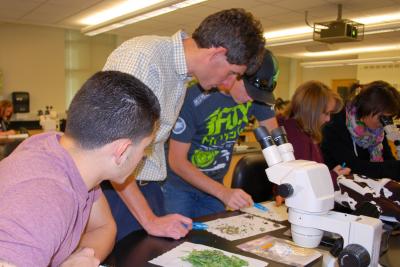NMSU professor teaches pest management using Google Maps

Brian Schutte, New Mexico State University assistant professor of weed physiology in the Department of Entomology, Plant Pathology and Weed Science, has used Google Maps not just as a GPS tool, but also to solve logistical problems in his research. This semester, he decided to incorporate a more modern and interactive approach to one of his introductory courses. His idea is to create a pest database, using Google Maps.
"The objective for this course is for students to observe and study weeds, pests and plant diseases in different agricultural environments," Schutte said. "Students like interacting with things online and anyway that we can do that increases their interest."
Students taking the EPPWS 100L course have taken several field trips throughout the semester, covering areas east of "A" Mountain all the way to the NMSU Leyendecker Plant Science Center.
"I didn't realize that there are so many bugs around us," said Joseph Wood, who is majoring in agricultural biology. "The insects are countless, and there is an amazing world that I never realized was there."
The areas covered are chosen for their diversity. Some include chile or cotton fields. Others are very particular to southern New Mexico with crops such as pecans or alfalfa or rangeland environments.
"Each week, we visit a different site, either rural or urban, to observe pests," Schutte said. "Students then write reports on a pest of their choosing. These reports are eventually posted on Google Maps."
The Google Maps database shows fine details of pests around campus. Users can zoom into a specific area and click to see a photo and a summary report on a particular pest. By the end of the semester, students will edit the map, adding information about the pest biology and management. They will also give their classmates a guided tour through the map they built.
"When we post things online, we post them to the map, so we get to see where many species are and it helps us correlate with different areas," said Sara Kelley, who is also majoring in agricultural biology. "I've learned a lot of the differences about ways to manage pests that is easier on the environment."
Schutte said using this interactive tool provides students with a better idea of the different environments in the area that require pest management and shows them the importance of pest management.
"One of the objectives of this course is for students to learn to gather information and communicate that information. They have to find reliable sources and use clear communications skills. Students are also learning other ways to share information in addition to writing reports," he said.
In class, students were paired and given plastic bags containing the pests they had gathered the previous week. The room grew louder as students began examining each insect under a microscope.
"It is a way to maintain student excitement about the field," Schutte said. "For some, this is their first class in our department, and I want them to come out of this class excited about the major they've chosen, and to look forward to the classes that are yet to come."
Although the database will not be made public soon, it is one of Schutte's goals.
"At the moment, I do not want to open that database, so the next class can develop their own and not rely on this class or be tempted to look at other people's information, because in a way, they are writing their own textbook," he said. "The map will be available to students as long as Google is in existence."
The impact of this interactive tool will be seen in a few years as more information is gathered and changes in pests and the environment are compared year to year.
"What we have done is provided students another opportunity to interact with information," Schutte said. "We will be revisiting the same sites and through this project with Google Maps we will be able to see the trends and changes in the environment."


